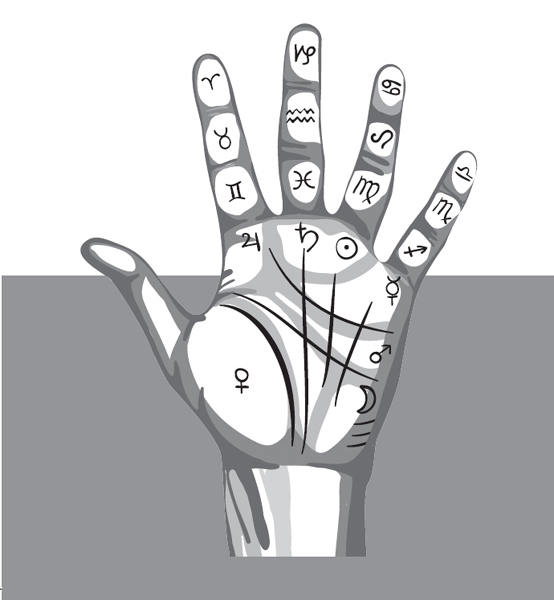
Always look at both hands for evidence about the love and relationship lines because the minor hand can often be more revealing and accurate when dealing with this emotive area of a person's life. The attachment lines are little creases that enter the palm horizontally from the percussion edge of the hand in the area between the bottom of the little finger and the heart line. Some old time palmistry books say that these lines show how many children a person will have, but this is not so.
The lines refer to adult relationships. In the old days, this meant marriage—but hands do not register marriage certificates, so these lines refer to relationships that we feel strongly about. Sometimes a marriage may register a faint or stunted line while an affair can deposit a disproportionately heavy one.
One really hot tip is to focus on the color of these lines and the area surrounding them. If it is the same as the rest of the hand, changes are unlikely to occur in the short term. However, if there is redness, dark coloration or many little muddled lines in the area, the subject could be very unhappy about the state of his relationship to the point where something dramatic is likely to happen.
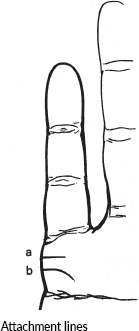
There may be one strong line, two lines, more than two or a number of strong lines with perhaps a few vague ones as well. These lines can appear, disappear and change their appearance remarkably rapidly. It would be nice to say that one line means one attachment, two means two and so on, but this area of hand reading is all about feelings. It concerns the contents of a person's head and heart rather than concrete facts. You will see what I mean as we go through this chapter.
Although there is no hard and fast rule, I have found that it works well if you read attachment lines by starting with the lowest and working upward. The lowest line often symbolizes the first important relationship, with later ones coming in turn as you climb up toward the base of the Mercury finger.
In theory, one strong attachment line means one long partnership, but it can also show what the subject wants in an ideal world. If a relationship fails, this person will try to find another and make that one work. This man is romantic rather than calculating. He is loving and giving and not particularly cautious and self-preserving. He (or more likely she) buys into the romantic ideal of finding a soul mate or falling into the arms of an understanding lover who supplies every emotional need. If this person is lucky, the first and only relationship is wonderful and it endures. The subject marries and lives happily ever after. As you can imagine, it is rare for anyone to attain this ideal—but the line shows that this is what the person wants, and what he will try to achieve.
If such a subject has more than one relationship during his lifetime, he will probably only concentrate on only one of these at a time. Thus, if there is an affair during the course of a marriage, the affair will count more than the marriage itself in emotional terms. If this individual loses a lover, he will not forget the past love but he will go on, in due course, to love again. In many cases, a faint additional line will grow above the original one later on.
When there are two attachment lines, the individual weighs up his relationship rather than simply trying to make the best of a bad job of it. He will question whether he really wants to stay in the partnership forever. He may not admit this openly, but somewhere deep inside him, there is a small voice telling him that his marriage is not right. Two marriages are a strong possibility here.
Young people often display several faint lines while they are still playing the field or looking around. The same can arise in a longish period between partnerships. In this case, it is best to concentrate on any lines that stand out. If no line really stands out, the person is not yet ready to settle down. Later on, some of the lines will fade away and one or two stronger ones will emerge.
There are many factors to look at here and some are not pleasant. Here is the worst-case scenario—that of foretelling the death of a partner.
The attachment line becomes deeper, slightly chained and turns up to touch the crease at the base of the Mercury finger, or there is a separate ring under the Mercury finger. In this case, the person will lose a partner through death. This mark seems to form on the hands a few years before the death occurs. I have seen this in the case of people who have left a partner, moved on to another, and then heard that the previous partner has died.

Now let's look at the illustrations and see what they tell us. The first illustration shows two lines. One line is straight and the other line bends downward. A person can have one line and that can be perfectly straight or it may curve downward. He may have two lines, one of which is straight and the other curved. The variations are enormous.
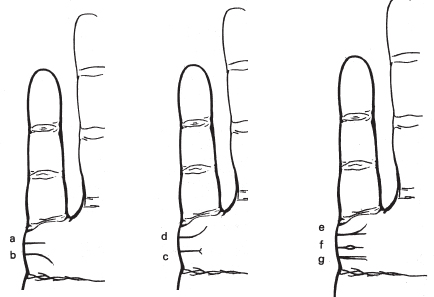
In the first illustration, the straight line (a) belongs to the person who wants (or has) one good relationship that exists for a long time. The bent line (b) shows a similarly long relationship but the individual will become depressed at times because the partner puts upon him, uses him or even bullies him.
In the second illustration, there is one line that turns upward (d) and one that has a little fork at the end (c). The line that turns upward suggests that the subject's partner is successful in his field and that he or she may be wealthy. In this case, look for a cross on the mount of Jupiter as that also signifies marrying money. The forked line shows a marriage or relationship that comes to a sudden end.
Looking at the third illustration, an island (f) on an attachment line suggests that the partner is sick or is likely to become sick soon. Alternatively, the partner may have financial, business or other problems on his mind at the time of the reading. This is a warning to keep an eye on the partner for a while.
A forked line or a frayed line (e) suggests that the relationship is in difficulties.
Parallel lines (g) suggest that the partners coexist in the same house but that the marriage is not emotionally satisfying.
A line that forks or doubles at the percussion edge but which then blends into one line shows a strong element of friendship in the marriage. It is possible that the partners started out as friends before getting together.
A line that has a finer companion line above or beneath suggests that the person has other interests apart from the partner. Many things could come between the subject and his lover but an affair outside marriage is a common scenario.
I have a funny story to tell here. Many years ago, I took a course that qualified me to teach adults in any adult education institute in the world. The people in the course hoped to teach anything from cookery to flower arranging, picture framing, office skills, car maintenance, care for the elderly and many other non-academic subjects. Needless to say, I wanted to teach astrology and palmistry. Toward the end of the course, we all had to make some kind of presentation. Some used practical hands-on techniques, while others used various different methods that we had learned along the way. We did our presentation in front of the students and the various teachers who worked on the course. It fell to me to use an overhead projector for my presentation so I decided to ask a guinea pig to allow me to take a hand print and I used that for my offering. One of the teachers offered his hand for the reading, but I doubt whether he realized just how detailed palmistry would be in the hands of an expert.
I started my presentation by going through the lines one by one, and soon I was lost in my art and oblivious of the effect that my reading might be having on my audience or my guinea pig. Eventually I came to his attachment lines. I remarked on the companion line alongside his main attachment line and commented that he was very likely embroiled in an affair that was a danger to his marriage. Up to this point, my audience had been listening quietly and attentively, but then there was a sudden communal intake of breath. I turned to the teacher in question and noticed that his face was as white as a sheet. Unbeknownst to me, he was in the throes of a passionate affair with another staff member. Shortly after this revelation, he dropped her and went back to his wife. Oh dear!
So now, let us get back to the business in hand . . . so to speak.
If a deletion line appears close to an attachment line or if it runs through the attachment line (h), the marriage is wedged so far on the rocks that a split is likely.
A square over an attachment line can mean restriction, but it can also signify that the partner is protected while in a difficult or dangerous situation.
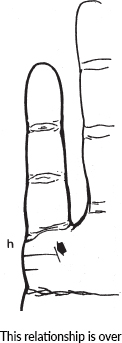
Child lines run vertically through the attachment lines. They can be on the percussion edge just where it curves round to the palm or just into the palm. These are difficult for even a good palmist to judge as they are often very fine and difficult to see. Try sprinkling a little talcum powder on this area of the hand, because that will make these lines stand out clearly. A child line should cut through at least one of the attachment lines.
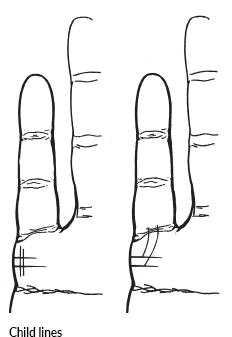
Generally, one line means one child, two means two children, and so on. Straight lines can refer to sons while sloping ones tend to refer to daughters. However, this can refer to the nature of the child, because a gentle, artistic boy will sometimes show up as a sloping line and vice versa. When child lines are close together, the children are close in age. A gap may show that the children are dissimilar to each other or that there is a gap in their ages.
Sometimes a subject has these lines but doesn't have children. In this case, ask if he or she looks after children or teaches them because someone who enjoys being with children may have many fine lines here. The same goes for someone who brings up children that are not his own. This can also apply to a person who cares for animals.
The rules for disturbances on the child lines are similar to those for any other line. Here are a few common scenarios:
Sibling lines refer to brothers and sisters. They can also refer to cousins, neighbors and good friends who feel like brothers and sisters. These are on the opposite side of the hand to attachment lines. There are some clues that you can pick up from these.
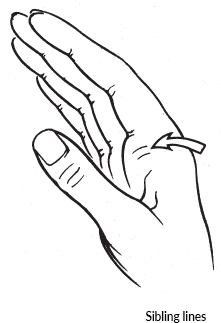
Unless a person decides to be a recluse or a hermit, life will be full of relationships of one kind or another, and there are many features on a hand that talk of our connection with other people. One that is worth looking out for is a stray line or two—or sometimes a whole bunch of them—that reach out from the mount of Venus and wander across the hand. These are interference lines. They show how we allow parents, partners and others to cramp our style and dictate to us. If you see such lines, trace their path and see which area of the hand and which lines they cross. This will show the areas that are being restricted or affected by the dictatorial or meddling person.
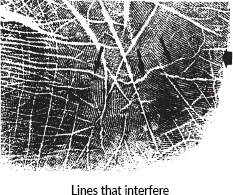
It is possible to fall in love with someone in an instant—indeed many passionate attractions start in just that way. The coup de foudre, the meeting with a stranger that turns our knees to jelly and that soon becomes a matter of heated desire, passion, pain, ecstasy and so on is a rare but unforgettable experience. The clue to this is when the line of health connects with one of the attachment lines. Perhaps this means that a traumatic affair can be bad for one's health?